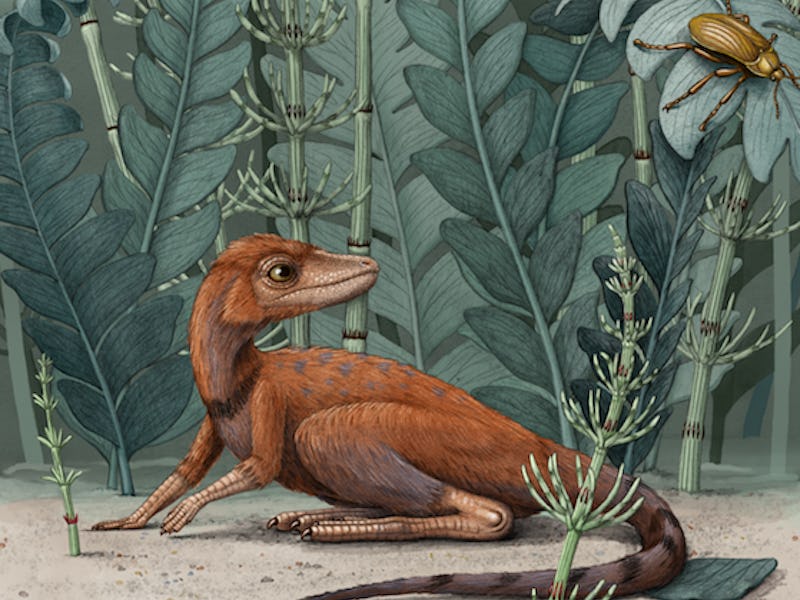Scientists find a 237-million-year-old miniaturized origin for giant dinosaurs
Being small "may have helped this group to flourish."

The group that includes some of Earth's most massive dinosaurs and pterosaurs just got a little bit smaller.
In Madagascar, researchers discovered a previously unknown species of ancient reptile named Kongonaphon kely. It's part of the ancient animal group Ornithodira — the last common ancestor between dinosaurs and winged pterosaurs.
Kongonaphon stood just shy of four inches tall, a far cry from some of the massive creatures that also comprise Ornithodira. In a study published Monday in the journal Proceedings of the National Academy of Sciences, researchers describe its 237-million-year-old fossilized skeleton.
The bones discovered were mainly limb material but they also include a preserved upper jaw bone and "peg-like, unserrated teeth," study author Christian Kammerer, curator of paleontology at North Carolina Museum of Natural Sciences, tells Inverse, "suggesting an insectivorous diet for this tiny predator."
In an illustration of Kongonaphon, the tiny reptile perches on human hands with room to spare, putting its size into perspective. It's extremely reminiscent of when Yoshi battles Master Hand in Super Smash Bros.
Artist's rendering of Kongonaphon compared with human hands.
Kongonaphon is a new addition to the group of prehistoric reptiles known as lagerpetids. They're unlike any animals living today, Kammerer says.
"Lagerpetids are generally thought to be light-bodied, long-legged animals that would not have been especially similar to any living species," he explains.
This is the first time researchers have discovered a jaw from a lagerpetid. Overall, scientists think lagerpetids were likely bipedal, and on the smaller side, with the Kongonaphon being the smallest.
Because of its tiny size, the researchers first had to determine that Kongonaphon wasn't actually a hatchling. They cut open one of the fossilized bones to analyze a cross-section, like counting rings on a tree, to determine that it's a likely the bone of a mature animal.
In turn, they discovered that it was simply miniature. Miniaturization describes animals with smaller adult body size, relative to their evolutionary lineage. Animals might become smaller when it benefits their evolution — smaller animals may need fewer resources, helping them survive in scarce times, for example.
Researchers think that Kongonaphon represents a broader trend toward miniaturization among ornithodirans during the Triassic. Since the species are much smaller than the ones they evolved from, that means at some point, animals sized down.
"It seems the origin of ornithodirans was associated with a 'size squeeze,'" Kammerer says, "which may have helped this group to flourish at a time when large-bodied roles in terrestrial ecosystems were mostly being filled by crocodile-relatives and protomammals."
Tiny Kongonaphon compared with Herrerasaurus, one of the earliest-known dinosaurs.
In the case of Kongonaphon, being smaller and eating insects might have helped to survive climate extremes. Both dinosaurs and pterosaurs are known to have fuzzy skin and feathers, which also may be part of thermoregulation.
The new study helps to explain why researchers still have some major gaps in the ornithodiran fossil record.
Take pterosaurs: The earliest record of the group is already a winged, fully-flying animal, Kammerer explains. So far, he says, scientists have found "no good intermediates between fully terrestrial reptiles and flying pterosaurs."
That likely means something is missing in the fossil record. For birds in the Jurassic and Cretaceous, Kammerer explains, researchers have turned up "an incredibly rich series of 'protobird' dinosaur fossils" which show, step-by-step, how the animals adopted bird characteristics.
If ornithodiran underwent a miniaturization process, it would help to explain why early stages of pterosaurs are missing: Small, delicate bones are harder to come by because they don't stay preserved as well as larger bones. They are also more likely to be mashed up by scavengers or geologists.
"I suspect that early ornithodirans were not rare components of their ecosystems, they were probably common and quite diverse, but few have been preserved in the deposits traditionally focused on by Triassic workers," Kammerer says.
In the future, Kammerer predicts that further studies will uncover more tiny ornithodirans like Kongonaphon.
Abstract: Early members of the dinosaur–pterosaur clade Ornithodira are very rare in the fossil record, obscuring our understanding of the origins of this important group. Here, we describe an early ornithodiran (Kongonaphon kely gen. et sp. nov.) from the Mid-to-Upper Triassic of Madagascar that represents one of the smallest nonavian ornithodirans. Although dinosaurs and gigantism are practically synonymous, an analysis of body size evolution in dinosaurs and other archosaurs in the context of this taxon and related forms demonstrates that the earliest-diverging members of the group may have been smaller than previously thought, and that a profound miniaturization event occurred near the base of the avian stem lineage. In phylogenetic analysis, Kongonaphon is recovered as a member of the Triassic ornithodiran clade Lagerpetidae, expanding the range of this group into Africa and providing data on the craniodental morphology of lagerpetids. The conical teeth of Kongonaphon exhibit pitted microwear consistent with a diet of hard-shelled insects, indicating a shift in trophic ecology to insectivory associated with diminutive body size. Small ancestral body size suggests that the extreme rarity of early ornithodirans in the fossil record owes more to taphonomic artifact than true reflection of the group’s evolutionary history.
This article was originally published on